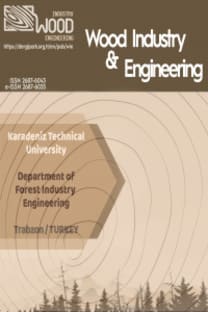MÜHENDİSLİK AHŞAP ÜRÜNLERİNİN PERFORMANS ÖZELLİKLERİNİN BELİRLENMESİ ÜZERİNE BİR ARAŞTIRMA
Mühendislik ahşap ürünleri sektöründe yer alan mühendis ve mimarların yanı sıra akademisyenlere anket uygulanmıştır. Mühendislik ürünü ahşap malzemelerin performans özelliklerinin ve araştırma ihtiyaçlarının belirlenmesi, anket çalışması adı altında incelenmiştir. Çalışmada anket sonuçları SPSS programında değerlendirilmiştir.
Çalışma sonucunda katılımcılar, yapısal ahşap ürünlerin yapısal performansının, çevresel performansının ve yangın performansının önemli olduğu sonucuna varmışlardır. Buradan hareketle yapı sektöründe kullanılacak nihai tüketicilerin olumsuz olgularının bu çalışma ile yok edileceği düşünülmektedir.
Anahtar Kelimeler:
Mühendislik Ürünü Ahşap Malzemeler, SPSS, ANKET
A RESEARCH ON DETERMINING THE PERFORMANCE PROPERTIES OF ENGINEERED WOOD PRODUCTS
The survey was carried out to academicians as well as engineers and architects who are in the engineering wood products sector. Determination of the performance characteristics and research needs of engineered wood products was investigated under the name of a survey study. In the study, the survey results were evaluated in the SPSS program.
As a result of the study, the participants came to the conclusion that the structural performance, environmental performance, and fire performance of structural wood products are important. Based on this, it is thought that the negative phenomena of the final consumers who will be used in the building sector will be destroyed by this study.
Keywords:
Engineered Wood Products, Survey, SPSS,
___
- ANSI/APA PRG 320, 2013. Standard for Performance-Rated Cross-Laminated Timber. American National Standards Institute, Washington, DC.
- Ametepey S.O. and Ansah S.K. (2014). Impacts of construction activities on the environment: the case of Ghana. Journal of Construction Project Management and Innovation, 4(sup 1), 934-948.
- Takino A., Shimokawa C., Ishiyama H. and Nakano R. (2018). A Study on the Failure Properties and Mechanisms of Bearing Walls Combining Support and Lath Plaster in Modern Wooden Buildings. Collected Articles, 83 (752), 1477-1485.
- Brandner R., Flatscher G., Ringhofer A., Schickhofer G. and Thiel A. (2016). Cross-laminated timber (CLT): overview and development. European Journal of Wood and Wood Products, 74(3), 331-351.
- BS EN 338 (2009). Structural timber. Strength classes. British Standards, London, United Kingdom. Buyukozturk S. (2010). Data Analysis Handbook, Pegem Academy Publishing, 12.
- Cokluk O., Sekercioglu G. and Buyukozturk S. (2012). Multivariate statistics for social sciences: SPSS and LISREL applications (Vol. 2). Ankara: Pegem Academy, 207.
- Gu H., Nepal P., Arvanitis M. and Alderman D. (2021). Carbon impacts of engineered wood products in construction. Engineered Wood Products for Construction, 233-246.
- Ekundayo O.O., Arum C. and Owoyemi, J. M. (2020). Forest Product Industry and Engineered Wood Products: The Nigerian Experience. Journal of Applied Sciences and Environmental Management, 25(1), 93-97.
- Karacebeyli E. and Douglas B. (2013). CLT handbook-US edition. FPInnovations and Binational Softwood Lumber Council, Point-Claire, Quebec.
- Karagoz Y. and Kosterelioglu I. (2008). Developing the communication skills assessment scale by factor analysis method. Dumlupınar University Journal of Social Sciences, 21.
- Mehta M., Scarborough W. and Armpriest D. (2008). Building construction: Principles, materials, and systems (pp. 817-877). Ohio: Pearson Prentice Hall.
- Ortiz O., Castells F. and Sonnemann G. (2009). Sustainability in the construction industry: A review of recent developments based on LCA. Construction and building materials, 23(1), 28-39.
- Pacheco-Torgal F. and Labrincha J.A. (2013). The future of construction materials research and the seventh UN Millennium Development Goal: A few insights. Construction and building materials, 40, 729-737.
- Pratt G.H. Coday A.E. and Maun K.W. (2010). Timber Drying Manual, 3rd ed. Bracknell, IHS BRE Press.
- Ramage M.H., Burridge H., Busse-Wicher M., Fereday G., Reynolds T. Shah D. U., ... and Scherman O. (2017). The wood from the trees: The use of timber in construction. Renewable and Sustainable Energy Reviews, 68, 333-359.
- Puetmann M. and Wilson J., (2005). Life-Cycle Analysis of Wood Products: Cradle-Togate LCI of residential wood building materials. Wood Fiber Science, 37, 18-29.
- Smith I., Snow M. and Asiz A. (2006). Failure Analysis of Engineering Wood Products. In Fracture of Nano and Engineering Materials and Structures (pp. 1193-1194). Springer, Dordrecht.
- Sun X., He M. and Li Z. (2020). Novel engineered wood and bamboo composites for structural applications: State-of-art of manufacturing technology and mechanical performance evaluation. Construction and Building Materials, 249, 118751.
- Yang X., Ma L., Zhao Q. and Yu Y. (2018). Enduring performance of self-tapping screw connection in wood members and WPC members. Wood Research, 63(5), 833-842.
- ISSN: 2687-6043
- Başlangıç: 2017
- Yayıncı: Karadeniz Teknik Üniversitesi
Sayıdaki Diğer Makaleler
MÜHENDİSLİK AHŞAP ÜRÜNLERİNİN PERFORMANS ÖZELLİKLERİNİN BELİRLENMESİ ÜZERİNE BİR ARAŞTIRMA
